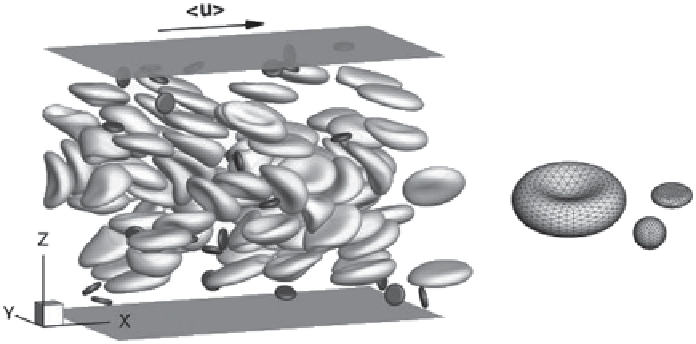Biomedical Engineering Reference
In-Depth Information
Fig. 9.1
Modelling red blood cells and platelets in a microchannel of 34 µm in height. (Image
from Zhao et al 2012)
For a multiphase flow, blood is represented by a two-phase macroscopic mod-
el, that is, a suspension of red cells (particles, also called erythrocytes) in plasma
(fluid) which is a Newtonian viscous incompressible fluid. Discrete elements can
be used to construct and model the elastic cardiovascular structures effectively and
will be the next state-of-the-art technique in this aspect. The disturbance of walls in
a flow channel is structurally influenced by flow velocity or by hydrodynamic drag
force. The use of nodal elements can allow us to compute the force two ways at all
nodes representing the vessel.
The term multiphase flow suggests that the red blood cells can be treated as
a deformable discrete phase moving through a flowing continuous phase in the
form of plasma. The Eulerian and Lagrangian perspectives introduced earlier in
Chap. 6 describe how the Arbitrary-Lagrangian-Eulerian mesh could be used for
FSI problems. In this same context the discrete red blood cells are treated in a
Lagrangian approach, tracked individually, while the continuous phase is in the
Eulerian approach. Zhao et al. (2012) used this approach to produce a suspension
of red blood cells and platelets flowing between two flat plates of a microchannel
of height 34 µm (Fig.
9.1
).
Their results showed the red blood cell suspensions under bulk shear and how
this shear induced particle migration. The particle velocity fluctuations were closely
related to the alignment of the red blood cells in suspension. It was observed that
greater shear was found in the near wall where the red blood cells became more el-
liptic than those in the centre of the microchannel. These behaviours demonstrate
that a continuous single phase description fails to capture the micro flow dynamics.
Srivastava and Srivastava (2009) also studied particle-fluid blood flow such as
the cell-plasma mixture. The accurate modelling of the real nature of blood in the
flow through the cardiovascular structure as well as the flow development of pat-
terns allows better understanding of the cardiac physiology. An accurate model can

Search WWH ::

Custom Search